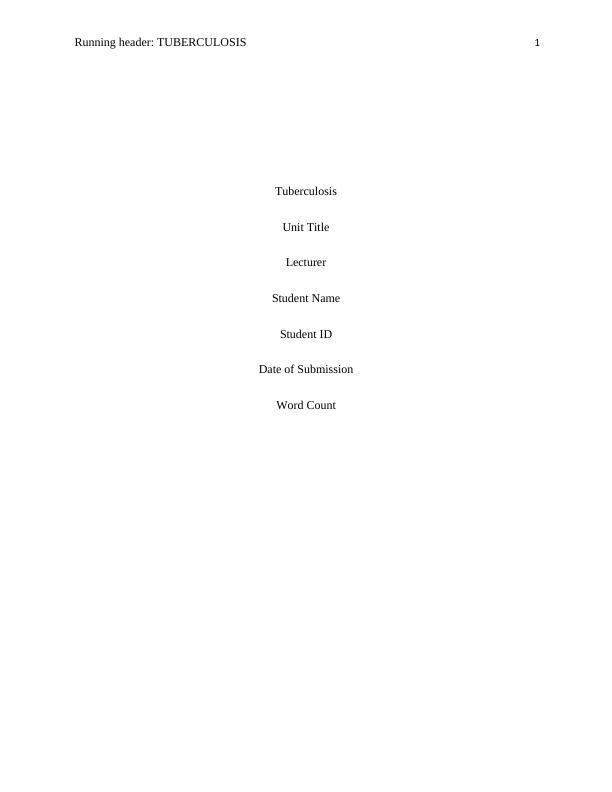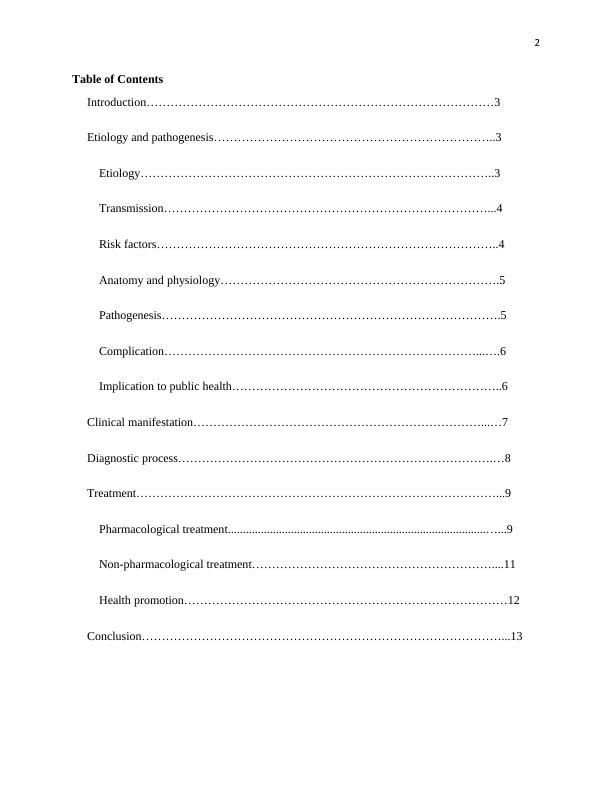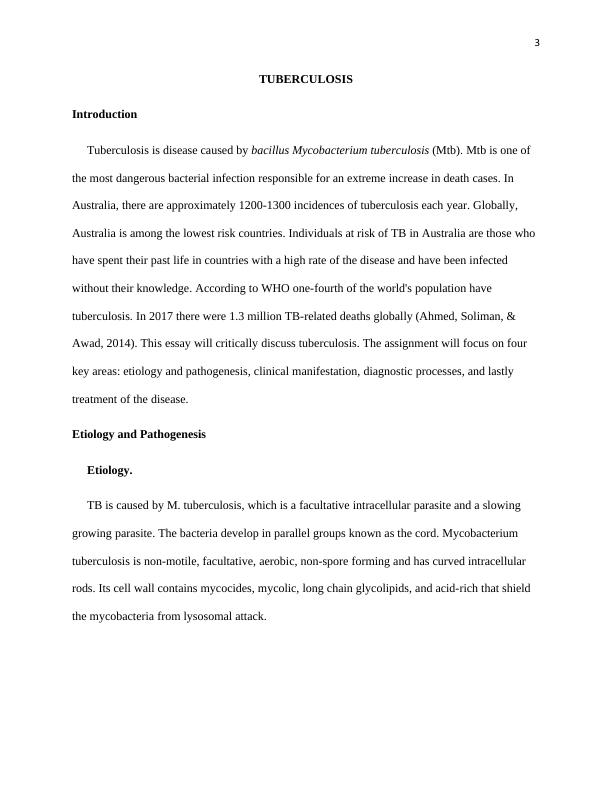Tuberculosis: Etiology, Pathogenesis, Clinical Manifestation, and Treatment
Added on 2023-01-20
15 Pages3096 Words65 Views
Running header: TUBERCULOSIS 1
Tuberculosis
Unit Title
Lecturer
Student Name
Student ID
Date of Submission
Word Count
Tuberculosis
Unit Title
Lecturer
Student Name
Student ID
Date of Submission
Word Count

2
Table of Contents
Introduction.......................................................................................3
Etiology and pathogenesis.......................................................................3
Etiology.........................................................................................3
Transmission....................................................................................4
Risk factors......................................................................................4
Anatomy and physiology......................................................................5
Pathogenesis.....................................................................................5
Complication.....................................................................................6
Implication to public health....................................................................6
Clinical manifestation..............................................................................7
Diagnostic process..................................................................................8
Treatment.............................................................................................9
Pharmacological treatment............................................................................................9
Non-pharmacological treatment................................................................11
Health promotion.................................................................................12
Conclusion.............................................................................................13
Table of Contents
Introduction.......................................................................................3
Etiology and pathogenesis.......................................................................3
Etiology.........................................................................................3
Transmission....................................................................................4
Risk factors......................................................................................4
Anatomy and physiology......................................................................5
Pathogenesis.....................................................................................5
Complication.....................................................................................6
Implication to public health....................................................................6
Clinical manifestation..............................................................................7
Diagnostic process..................................................................................8
Treatment.............................................................................................9
Pharmacological treatment............................................................................................9
Non-pharmacological treatment................................................................11
Health promotion.................................................................................12
Conclusion.............................................................................................13

3
TUBERCULOSIS
Introduction
Tuberculosis is disease caused by bacillus Mycobacterium tuberculosis (Mtb). Mtb is one of
the most dangerous bacterial infection responsible for an extreme increase in death cases. In
Australia, there are approximately 1200-1300 incidences of tuberculosis each year. Globally,
Australia is among the lowest risk countries. Individuals at risk of TB in Australia are those who
have spent their past life in countries with a high rate of the disease and have been infected
without their knowledge. According to WHO one-fourth of the world's population have
tuberculosis. In 2017 there were 1.3 million TB-related deaths globally (Ahmed, Soliman, &
Awad, 2014). This essay will critically discuss tuberculosis. The assignment will focus on four
key areas: etiology and pathogenesis, clinical manifestation, diagnostic processes, and lastly
treatment of the disease.
Etiology and Pathogenesis
Etiology.
TB is caused by M. tuberculosis, which is a facultative intracellular parasite and a slowing
growing parasite. The bacteria develop in parallel groups known as the cord. Mycobacterium
tuberculosis is non-motile, facultative, aerobic, non-spore forming and has curved intracellular
rods. Its cell wall contains mycocides, mycolic, long chain glycolipids, and acid-rich that shield
the mycobacteria from lysosomal attack.
TUBERCULOSIS
Introduction
Tuberculosis is disease caused by bacillus Mycobacterium tuberculosis (Mtb). Mtb is one of
the most dangerous bacterial infection responsible for an extreme increase in death cases. In
Australia, there are approximately 1200-1300 incidences of tuberculosis each year. Globally,
Australia is among the lowest risk countries. Individuals at risk of TB in Australia are those who
have spent their past life in countries with a high rate of the disease and have been infected
without their knowledge. According to WHO one-fourth of the world's population have
tuberculosis. In 2017 there were 1.3 million TB-related deaths globally (Ahmed, Soliman, &
Awad, 2014). This essay will critically discuss tuberculosis. The assignment will focus on four
key areas: etiology and pathogenesis, clinical manifestation, diagnostic processes, and lastly
treatment of the disease.
Etiology and Pathogenesis
Etiology.
TB is caused by M. tuberculosis, which is a facultative intracellular parasite and a slowing
growing parasite. The bacteria develop in parallel groups known as the cord. Mycobacterium
tuberculosis is non-motile, facultative, aerobic, non-spore forming and has curved intracellular
rods. Its cell wall contains mycocides, mycolic, long chain glycolipids, and acid-rich that shield
the mycobacteria from lysosomal attack.

4
Transmission.
When individuals with active TB spit, speak, sneeze or cough they release infectious air
droplets approximately 0.5 to 0.5 um in diameter. These droplets main remain airborne for
minutes to hours after expectoration. (Wanyeki, Olson, & Brassard, 2016).
Risk factors.
Tuberculosis is able to be transmitted from one individual to the other through the following
ways;
i. Number of organisms expelled
ii. Immune status of the individual
iii. Duration of exposure to contaminated air
iv. The concentration of the mycobacteria
Factors that raise the risk of an individual to get active tuberculosis to include the following:
i. Weakened immune system
An individual with a strong immune system often fights TB bacteria, but the body is not
capable of producing a defense mechanism if the body resistance to infection is low. medication,
diseases, and condition can weaken the immune system such as HIV/AIDS and chemotherapy
drugs (Ferrara, Murray, & Winthrop, 2015).
ii. Traveling or residing in certain areas
Transmission.
When individuals with active TB spit, speak, sneeze or cough they release infectious air
droplets approximately 0.5 to 0.5 um in diameter. These droplets main remain airborne for
minutes to hours after expectoration. (Wanyeki, Olson, & Brassard, 2016).
Risk factors.
Tuberculosis is able to be transmitted from one individual to the other through the following
ways;
i. Number of organisms expelled
ii. Immune status of the individual
iii. Duration of exposure to contaminated air
iv. The concentration of the mycobacteria
Factors that raise the risk of an individual to get active tuberculosis to include the following:
i. Weakened immune system
An individual with a strong immune system often fights TB bacteria, but the body is not
capable of producing a defense mechanism if the body resistance to infection is low. medication,
diseases, and condition can weaken the immune system such as HIV/AIDS and chemotherapy
drugs (Ferrara, Murray, & Winthrop, 2015).
ii. Traveling or residing in certain areas

End of preview
Want to access all the pages? Upload your documents or become a member.
Related Documents
Comprehensive Report on Tuberculosis Diseaselg...
|8
|2604
|28
Clinical Update: Tuberculosis Assignment 2022lg...
|15
|3835
|40
Disease and Body Defence: Categories, Transmission, Worldwide Importance, Tuberculosis and Antibiotic Treatmentlg...
|13
|1048
|475